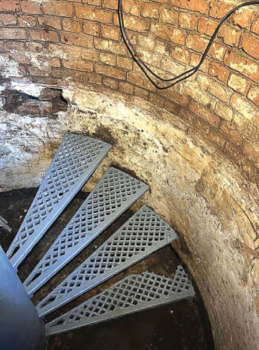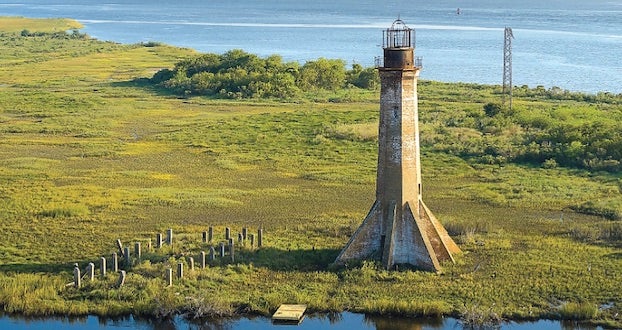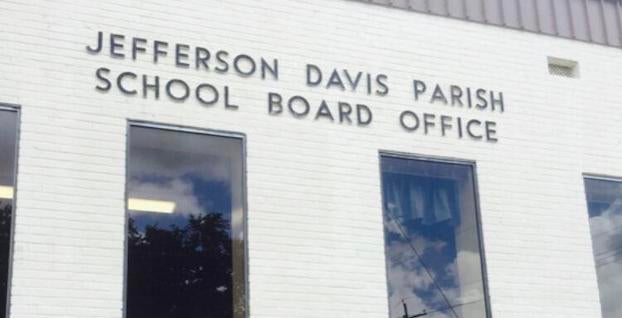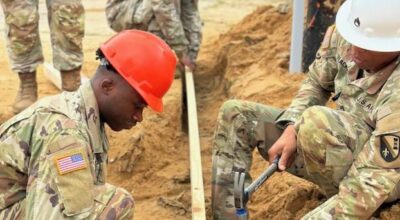For the love of a lighthouse: Restoration of Sabine Pass structure taking place one small step at a time
Published 6:30 am Monday, April 22, 2024
The Cameron Parish Sabine Pass Lighthouse, built in 1856, could be a shining example of historic preservation, a tourist attraction and perhaps the preeminent symbol for the state’s resilience – one of these days. For now, the 85-foot structure with a shape that resembles a rocket about to take off is being restored, one step at a time, mostly by volunteers, and with private donations.
“We have had around 200 volunteer hours by a few people this year, and we have applied for state and federal grant monies. So far, we haven’t been successful,” said Andrew Tingler, full-time meteorologist and president of the Cameron Preservation Alliance since 2016. (He would not mind turning over the reins, but so far, no takers.)
About every other week, when he can, Tingler takes the nearly two-hour drive to the lighthouse on the other side of the parish from his home in Grand Lake, dragging his 16-year-old son Jax along. Together they pick up debris. Jax has limed the oil house. Tingler might mow or prep for the next step, literally.
“The original cast iron staircase fell in 2008 during Hurricane Ike,” Tingler said. “All the debris just piled up inside the tower.”
In 2019 Cheniere Energy volunteers helped clean up, and build a bridge to the lighthouse. (The Cheniere Energy Sabine Pass LNG export facility is located next to the lighthouse.) In 2020, a suggestion by McNeese State University Engineering Professor and volunteer Ted Thompson resulted in the discovery of intact steps. Tingler chiseled one loose and shipped it off to make a cast. New steps were delivered last year, each funded by a donor.
Ricky Mouton volunteers his time cleaning the pole remnants. Engineer Byron Racca is looking into stairwell supports. The maintenance crew at Cheniere has agreed to install the pole and steps.
“The original quote for the 96 steps in 2020 was $900 per step, but by the time we ordered it was closer to $1,200,” Tingler said. “Individual donors paid $1,000 for each step.”
A light – or more specifically a six-foot 3rd order fresnel lens like the one that shone from Sabine Pass in its glory days – would be “icing on the cake – if we get to that point” Tingler said.
In 2016, he knew the project would be challenging.
“Honestly, I thought it would be done by now,” he said. It could take years even if we had the $3 million to complete our extensive checklist. It’s like working on an old home. Every time you think the project is moving along, another issue pops up, and you have to find someone to consult and problem solve with.”
History
In 1849, a US Navy Commander described the Sabine Pass Gulf Coast as free from danger, short on commerce and easily accessed. A lighthouse wasn’t needed, he said. Citizens and politicians thought otherwise. Work began. The lighthouse went into service then fell dark in 1861 and remained so for the duration of the Civil War. In 1865, the lighthouse was returned to service. It survived the hurricane of 1886 with the keeper and his family at the top. During the 1915 hurricane, the mechanism that turned the flash panels stopped working. The keeper and his assistant turned them by hand. This would not be the last hurricane that caused damage. The damage from Hurricane Laura in 2020 was minor, Tingler said. “The main problem was the road was cut by surge water and there was a spot that was eroding away. I had to file a permit with the Corps of Engineers, then Cheniere filled the hole.”
Laura and Delta also blew out a long-term temporary covering.
Electricity and a radio beacon were installed in 1929 and three 10-foot-wide black horizontal bands painted to make it more visible.
Tingler said it will be painted in this manner again, but there is much to do before that point.
Abandoned in 1952, the federal government turned the property over to Louisiana Wildlife and Fisheries Commissions for a field station. It was returned. In 1971, the property was given to Lamar to use as a research and teaching complex, but the expense was too much. They returned the property.
Between 1972 and 1976, the lighthouse was transferred to Louisiana State Parks and Recreation. Investors bid $55,000 for the site in 1986, and it remained in their hands until it was given to the Cameron Preservation Alliance in 2001. (This information is a brief summary from lighthousefriends.com).
Getting there
The Sabine Pass lighthouse is accessible to sightseers, but there is a process and the road might be a little rough, especially for cars that are low to the ground, but for the person who has never seen it and appreciates history and understands the appeal of the lighthouse, it could be worth the drive.
Visitors travel from across the state to see it, as well as from California, Wisconsin, Texas and Florida.
If you go
Call 337-569-2892 with driver and vehicle information. Pack mosquito spray. Travel La. 82 / Gulf Beach Hwy. to 9243 Gulf Beach Hwy. Pass through Cheniere Energy’s security checkpoint to gain access. (They have the right to turn anyone away. There have been communication issues, but they let most people through, according to Tingler.) Drive down 2-3 miles on the graveled road before a dead end near Lighthouse Bayou. The last couple of feet are really a hazard and cannot be graveled because it is wetland. Consider sharing photos and impressions with the Cameron Preservation Alliance Facebook page.
Note: At the time of this publication, Johnson Bayou Library is being renovated, but the number above redirects to another Cameron Parish library branch. If unable to coordinate details for a visit, call 409-460-1851.







